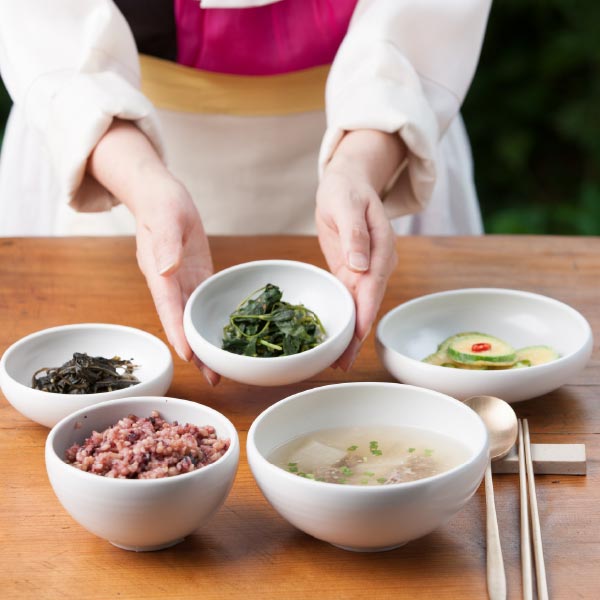KOREA
LAND OF THE MORNING CALM
Known for its green, hilly countryside dotted with cherry trees, centuries-old Buddhist temples, spellbinding natural beauty of picturesque high mountains, coastal fishing villages, sub-tropical islands and high-tech cities such as Seoul, Korea will surprise you with a dazzling range of experiences, beautiful landscapes and 5000 years of culture and history. Celebrate its traditions, arts crafts and refined cuisine by immersing in a memorable experience that will leave you a sense of serenity and splendid tranquillity.
DISCOVER MORE, MAKE YOUR LOGIN


DISCOVER
- Together with a traditional medicine doctor visit the Seoul Yangnyeong Market, established in the late 1960s when small medicinal herbs stores started opening one by one. Today, the market has grown to become the nationís largest oriental medicine market, and 70 percent of the oriental medicine traded in Korea goes through here. Continue your experience at the Sulwhasoo Balance Spa for a Contemporary Korean Medicinal Program. Recharge and restore balance among busy daily routine with exquisite techniques in a treatment room of natural light and comfortable music.
- With an expert botanist visit the Garden of Morning Calm in Gapyeong, the oldest private garden in Korea, it is an artistic space with a beautiful balance between the Korean concept of natural curves and plants.
- Get access to Tongin market, famous for its ìDosirakî (lunch box) concept and usage of traditional coins for buying and selling. Tongin Market dates back to 1941, as a public market set up for Japanese residents when Korea was still under Japanese rule. After the Korean War, the nation experienced a swift rise in population, which led to a natural increase in consumption and demand, as a result the areaís street vendors and stores used the former Market as their marketplace.
ART
- Together with an art historian visit the National Palace Museum of Korea, opened in 1992 displaying relics from the Joseon Dynasty [1392-1910]. Over 20,000 royal relics from Gyeongbokgung Palace, Changdeokgung Palace, Changgyeonggung Palace and Jongmyo Shrine are on display.
- Visit the Shuim Museum, it aims to preserve a forgotten culture by integrating it with contemporary culture and arts. Highlighting a theme of life and death, the museum remodeled the founderís house as an exhibition venue and resting area.
- Enter the the National Folk Museum of Korea, located inside Gyeongbokgung Palace, it presents historical artefacts used in the daily lives of Korean people in the past. Through the displays you will learn about the domestic and agricultural lifestyles, as well as Koreaís cultural beliefs.
- With its director visit the Haegang Ceramics Museum, established in 1990, it displays the history and development of making porcelain from the middle ages to modern times. Containing approximately 7000 invaluable items, the museum is an extraordinary research centre for ceramics. The museumís architecture is based on a delicate contemporary sensibility and traditional simple beauty.
- Discover one of the leading museums of Korea, the Leeum, Samsung Museum of Art, a place where traditional art, contemporary art and international art coexist harmoniously. Enjoy the permanent and special exhibitions with a knowledgeable museum docent.


TRADITIONS
- Visit Icheon Ceramic Village where you will experience the traditional mastership of high quality Korean ceramics; the village became the center of traditional pottery during the Joseon Dynasty (1392-1910) for about 500 years due to the easily obtainable materials in the area. Presently, about 80 pottery factories are congregated at the village, and about 300 pottery kilns are in use. Enter a local workshop and discover the secrets of this cultural treasure.
- Get access to Namsangol Hanok Village, a collection of five hanok (traditional Korean houses) from the Joseon Dynasty, recovered from different parts of the city and relocated to the northern foot of Namsan Mountain. The interiors of each of these five houses reflect owners from different social backgrounds, from the middle class to high government officials, noblemen and aristocrats. Enjoy a traditional Korean performance.
- With an expert chef learn how to prepare the traditional home meal and special dishes of the Korean cuisine; Korean cuisine mainly consists of rice, soup, cabbage, side dish and it is characterized different spices mixed with fermented vegetables or kimchi.
- Experience a meeting with a famous Korean Traditional clothing artist. She will show you the art of wrapping with Bojagi, Korean wrapping cloth that were used in the past for nearly everything: to carry books, groceries and food. Learn the etiquette of wearing an Hanbok, the Korean traditional dress and discover the tales of this peculiar clothing style.
EXPERIENCE
- Immerse in the Korean Buddhism and culture by visiting a temple and learn how these institutions have been the bedrock on which Korean culture has bloomed over the past 2000 years, since Buddhism was first introduced to Korea.
- Copying Sutras, Sagyeong, one of the most inspiring Buddhist practices, copy the sutras word by word by hand, let your mind step out the concept of time by immersing in this high meditative state.
- Tea Ceremony, practice mindfulness and concentration through brewing and drinking tea. When you drink tea, your five senses are all tuned to the same object of observation, the tea color, the sound of water, the scents and fragrances, the flavor and the warmth of the cup.
- Embark a private yacht for a cruise on Seoulís most iconic symbol, the Hangang River. Watch the sunset by sipping a glass of champagne and dine on board with local delicacies.
- Have a private class of Taekwondo, the traditional Korean martial art. It is a method of self-defense that uses hands and feet. Taekwondo became a worldwide sport after it was designated an official Olympic sport. Learn about the philosophy of Taekwondo and the basic movement during a private class.










































